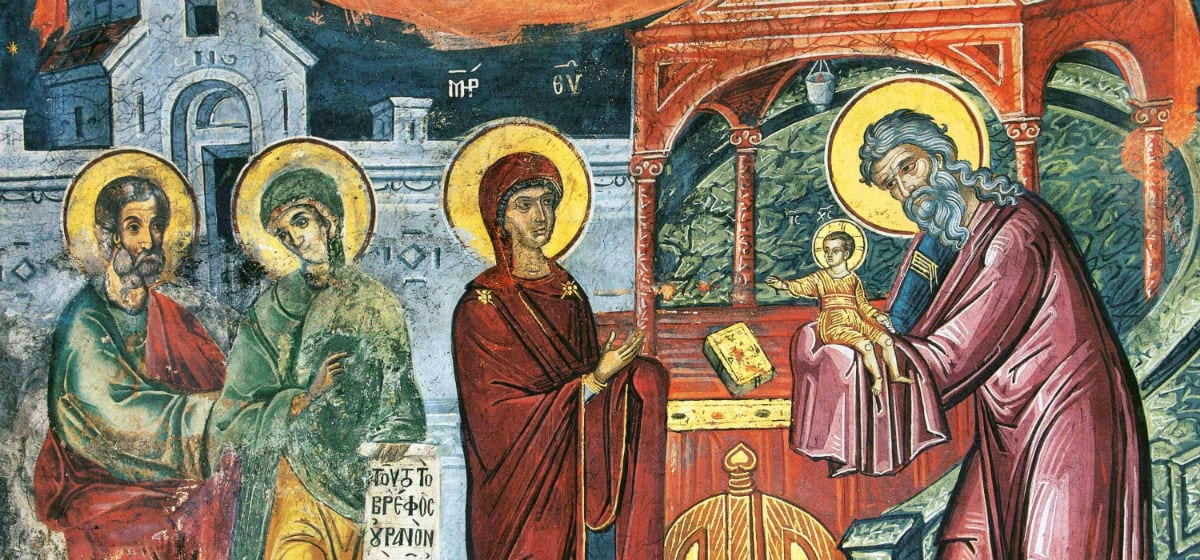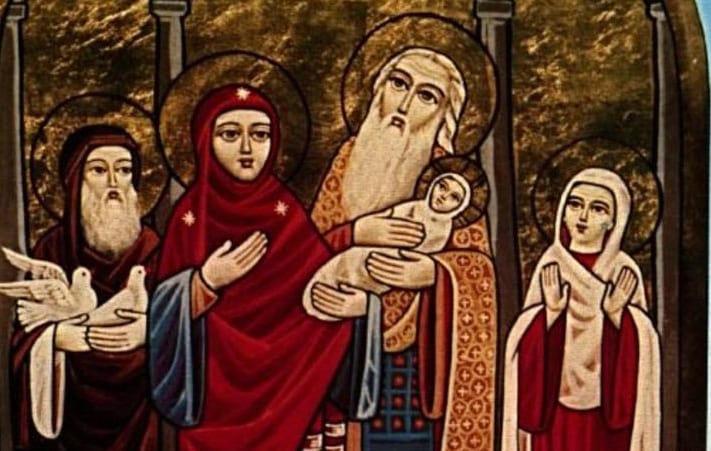Regina Caeli – Queen of Heaven, Rejoice!
The Regina Caeli, Latin for “Queen of Heaven,” is a hymn and prayer ...

This post is also available in: Spanish, Italian
February 2 is the feast of the Presentation of the Lord Jesus in the Temple. It commemorates Simeon’s famous prophecy that Jesus would be a “light of revelation to the Gentiles.” It is also known as Candlemas since it is the day that candles are blessed for use throughout the Church year.
To LISTEN to this post read by Dr. Italy, click on the play arrow on the left, directly below this paragraph.
I recently led a group of pilgrims to Jerusalem. As we stood at the foot of the Temple Mount and remembered the Presentation of Jesus, several people had questions. There were questions about the redemption of the first-born son. About the rite of purification after childbirth. About how to put Matthew and Luke together in terms of chronology and geography—Bethlehem, the Temple in Jerusalem, the flight into Egypt, and the return to Nazareth.
All these are very good questions. But they are not the questions that interest St. Luke. Neither are they the focus of the Feast of the Presentation, observed with great solemnity since the fourth century.
The most important thing about this feast is not even the intriguing prophecy of Simeon to Mary that a sword would pierce her heart “that the thoughts of many hearts would be revealed.”

Featured/above image by an unknown artist. Public domain.
What tips us off to the deepest meaning of the Presentation is the nickname it acquired early in Christian history– Candlemas. It is so-called because it is the day of blessing all the candles used in the Church throughout the year.
We like candles because they are cozy, homey, and festive. As a child, I used to love to light votive candles at the back of the church. They would continually remind God of my special intention, even when I had long since left the sanctuary. Today I love the cheerful, hopeful candles of the Advent wreathe. And there is nothing like a votive candle burning before an icon to help create an atmosphere of prayer.
These are good reasons to love candles. But the primary meaning of candles in the Catholic tradition is not to create atmosphere or to remind God to answer our prayers.
Simeon, after taking Jesus in his arms, proclaimed him to be “a light of revelation to the Gentiles” (Lk. 2:32). It is rather strange to bring up the Gentiles, given the circumstances and the location.
The circumstances? The Holy Family were fulfilling obligations of the Law of Moses, incumbent not on Gentiles, but on Jews. The location? They were standing in the Temple precincts, probably in the inner courtyard of Israel where Gentiles were forbidden to tread under pain of death. The Lord suddenly comes to his Temple (Mal 3:1). But he comes not to stay there. Neither is the plan for him to go forth from the sanctuary to enlighten just his own people. No, he has come to set the whole world ablaze.
This Light of revelation to all nations, for that is what “Gentiles” means, later came back to the Temple precincts as a grown man to celebrate the Feast of Tabernacles. On a festive autumn evening, while the Temple plaza was ablaze with torches and full of Jews dancing in celebration of their special relationship with the Almighty, Jesus echoed the words of Simeon and boldly proclaimed “I am the light of the world”(John 8:12).
To become a Christian in the early Church meant to have the darkness of despair scattered by this radiant light of revelation. In his light, everything looks different. A drab, grey world suddenly glitters with every color of the rainbow. What had been murky becomes clear. What was a conundrum now finally could be understood.
This was so much part of the early Christian conversion experience that baptism was called “the enlightenment” and the newly baptized, who wore white robes for the entire week after Easter, were called “the enlightened ones.”
To this day, the ancient rite of the Easter Vigil begins with a dark Church and the congregation waiting in anticipation. The Easter Candle is then lit from the new fire and, as the deacon proclaims “Christ our light,” smaller candles held by the faithful are lit from the Paschal candle and the flame rapidly spreads from candle to candle. The formerly darkened sanctuary now becomes ablaze with many hundred points of light.
This is stirring to watch. But I daresay we often miss the point. Yes, Christ is our light. But he has ignited us with the fire of his Spirit, and he calls us “the light of the world” (Mat. 5:14). We are not meant, any more than He was, to keep our light under the bushel basket of the home or our parish church. The light we have received is meant for an entire world languishing in darkness. The Presentation is a feast of mission, a reminder of the call to commit ourselves wholeheartedly to what our last three Popes have called “The New Evangelization.” The candles which we so enjoy in our liturgies and devotions are a reminder that we must not rest while there is even one left who remains in the valley of the shadow of death.
This Presentation post focuses on the symbolism of light and candles. It reflects on the readings for February 2, Feast of the Presentation of the Lord, (Malachi 3:1-4; Psalm 24; Hebrews 2: 14-18; Luke 2:22-40). This day is otherwise known as Candlemas.
For more on Candlemas or the Feast of the Presentation, see St. Sophronius on The Feast of the Presentation of the Lord.
To listen to a 14 minute PODCAST on this subject, listen to The Presentation – Simeon Sees the Light
Banner image a Coptic icon of the Presentation by Professors B. Latif and Y. Nasseef. Public domain.
IKRAM E ABDOU
Posted at 13:20h, 20 FebruaryThank you Dr. D’Ambrosio for posting this article about the Presentation of the Lord. I just want to point out that this image of the Holy Family, St Simeon, and St Anna is actually by two Coptic artists from Egypt, Professors B. Latif and Y. Nasseef. They posted many beautiful icons on a Church website, here’s the link but unfortunately it’s in Arabic.
https://www.avarewase.org/iconsalbum/
Jesse
Posted at 14:51h, 01 FebruaryFabulous
Frank LaRocca
Posted at 09:39h, 01 FebruaryHello Dr. D’Ambrosio,
I love all your articles you email to me. Helps me reflect on the church celebration each week and adds understanding by interpreting the Gospel. You mention this :
About how to put Matthew and Luke together in terms of chronology and geography—Bethlehem, the Temple in Jerusalem, the flight into Egypt, and the return to Nazareth. In this article but did not explain it. I’ve been curious as to how the holy family went to the temple after 40 days when they had fled to Egypt to avoid Herod’s persecution? Can you explain this? Maybe the three wise men came after 40 days and that is when they fled to Egypt?
Thank you
Dr. Marcellino D'Ambrosio
Posted at 17:12h, 28 MarchFrank, the Church does not officially tell us how to reconcile the infancy narratives of Matthew and Luke in matters of chronology. But traditionally, most commentators, both Catholic and Protestant, have put things together as you suggest . . . that Mary and Joseph remained in Bethlehem for an extended time and that the Magi would have visited during this time, after the Presentation. The flight to Egypt would have followed.
John Magri
Posted at 20:34h, 01 FebruaryHi.
The promo video, “Jesus: The Way, the Truth and the Life” seems really good. I did not see, however, where I can obtain a copy of it. Could you provide me with details please.
Dr. Marcellino D'Ambrosio
Posted at 15:27h, 02 FebruaryHi John. If you’d like a DVD, the study guide and book (the starter pack) which includes streaming access, you can obtain it from our ministry which will ship internationally https://www.crossroadsinitiative.com/product/jesus-the-way-the-truth-and-the-life-starter-pack/. If you’d like streaming access and online materials only, you can obtain it from the publisher, Ascension Press https://ascensionpress.com/products/jesus-the-way-the-truth-and-the-life-online-video-access